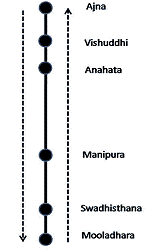Bhutashuddhi Kriya
Introduction
Bhutashuddhi Kriya (also known as Kundalini Pranayama) is a wonderful Pranayama that cleanses Sushumna and
makes Kundalini flow through it. Human body consists of five great elements
namely earth, water, fire, air and space. During creation of this body
transformation takes place in the order Shiva - Shakti - Mind - Space - Air
- Fire - Water - Earth. Yoga aims at reversing this order such that earth
dissolves in water, water in fire, fire in air, air in space and so on till
the source (Shiva) is reached. The first five chakras (from Mooladhara to
Vishuddhi) are representation of one element each (from earth to space). The
Bhutashuddhi Kriya cleanses all the five elements (bhutas) thereby hastening
the dissolution and thus Self-realization.
Technique

- Sit in any meditative posture with spine and head erect
- Close the eyes and relax the whole body
- Start inhaling slowly and steadily
- As you inhale contract your throat slightly so as to produce
a soft hissing sound.
- As you inhale let your awareness revolve along the Sushumna
across each chakra one at a time
- Start from Mooladhara
- As you become aware of a chakra, mentally chant its bija
mantra. For example, at Mooladhara mentally chant Lam mantra, at
Swadhisthana chant Vam mantra and so on till you reach Ajna. To
aid visualization you can visualize a flower, lotus or light at
the chakra point.
- As you reach Ajna chakra let the awareness descend the
Sushumna path and chant bija mantra as mentioned before in
reverse order
One ascent and one descent is one cycle of Bhushuddhi Kriya.
Beginners should do this kriya for 10 minutes gradually increasing
the time. As a variation you can substitute bija mantra and chakra
awareness with the following:
- As you inhale visualize a stream of light particles
ascending like a snake from Mooladhara to Ajna through the
spinal column and as you exhale visualize the stream descending
from Ajna back to Mooladhara
- As you inhale let the sound of inhalation (Sooo....) ascend
from Mooladhara to Ajna through the spinal column and as you
exhale let the sound of exhalation (Hammm....) descend from Ajna
back to Mooladhara. This unspoken mantra of breath is known as
Soham, Hamsa or Ajapa Japa.
For exact chakra location and their bija mantras see
FAQs section.
Signs of correct practice
- A feeling of bliss, joy and harmony is generated
- Divine visions may come to the practitioner
- Entire personality starts changing in positive sense
- Mind becomes calm and peaceful
- Meditative state is attained
- A tingling sensation may be felt during ascent and descent after
reasonable amount of practice
- During advance stages your breath becomes slow and steady. It may
even stop momentarily.
Signs of erroneous practice
- Lack of synchronization between mantra and chakra point
- Pain in throat or a feeling of soreness
- Bending of spine with inhalation and exhalation
- Wandering away during the practice
- Lack of focus on each chakra
- Forgetting to chant bija mantra
Scriptural references
The above technique is mentioned directly or indirectly in the
following Yogic texts:
- Kularnava Tantra
- Vijana Bhairav Tantra
- Yoga Chudamani Upanishad
- Goraksha Paddhati
- Bhagvat Gita
- Yoga Shikha Upanishad
Bipin Joshi is an independent software consultant and trainer by profession specializing in Microsoft web development technologies. Having embraced the Yoga way of life he is also a yoga mentor, meditation teacher, and spiritual guide to his students. He is a prolific author and writes regularly about software development and yoga on his websites. He is programming, meditating, writing, and teaching for over 27 years. To read more about him go here. More details about his Kriya and Meditation online course are available here.